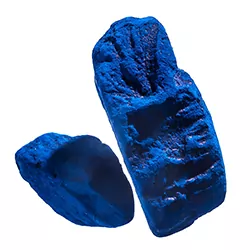IUPAC Name
(2Z)-2-(3-oxo-1H-indol-2-ylidene)-1H-indol-3-one
Cas Number
482-89-3
HS Code
32030040
Formula
C16H10N2O2
Industry
Textile Chemicals
Appearance
Dark-Blue Powder with Coppery Luster
Common Names
(delta-2,2'-biindole)-3,3'-dione; 2-(1,3-Dihydro-3-oxo-5-sulpho-2H-indol-2-ylidene)-3- oxoindoline-5-sulphonic acid; Indigo Blue
Packaging
25kg/woven bag, 25kg/ iron drum, 25kg/plastic drum
Brief Overview
Indigo dye is a natural or synthetic dye that produces a deep blue color. Historically, it has been derived from the leaves of certain plants, particularly the Indigofera genus, which contains a high concentration of the blue pigment. The process of extracting the dye involves fermentation and oxidation of the plant material.
Today, synthetic indigo dyes are more commonly used in the textile industry due to their availability, cost-effectiveness, and consistency in color. However, there's also a growing interest in natural indigo due to its sustainability and eco-friendly aspects, leading to its revival in certain artisanal and sustainable textile practices.
Indigo dye is made from the leaves of Polygonum Tinctorium. The indigo leaves are fermented for 2 to 3 months into a black clump with 2 - 10 % of indigo pigment. Wood ash, lime and bran are then mixed with the indigo clump and subjected to further water mixing, heated to 30~40℃, and then dried to form insoluble blue indigo.
Indigo is subjected to sulfonation with concentrated sulfuric acid, followed by dilution and then neutralization with soda ash. Sodium chloride is then added for salting out, before the mixture is filtered, washed and dried to get the finished product.
Brief Overview
Indigo dye is a natural or synthetic dye that produces a deep blue color. Historically, it has been derived from the leaves of certain plants, particularly the Indigofera genus, which contains a high concentration of the blue pigment. The process of extracting the dye involves fermentation and oxidation of the plant material.
Today, synthetic indigo dyes are more commonly used in the textile industry due to their availability, cost-effectiveness, and consistency in color. However, there's also a growing interest in natural indigo due to its sustainability and eco-friendly aspects, leading to its revival in certain artisanal and sustainable textile practices.
Indigo dye is made from the leaves of Polygonum Tinctorium. The indigo leaves are fermented for 2 to 3 months into a black clump with 2 - 10 % of indigo pigment. Wood ash, lime and bran are then mixed with the indigo clump and subjected to further water mixing, heated to 30~40℃, and then dried to form insoluble blue indigo.
Indigo is subjected to sulfonation with concentrated sulfuric acid, followed by dilution and then neutralization with soda ash. Sodium chloride is then added for salting out, before the mixture is filtered, washed and dried to get the finished product.
